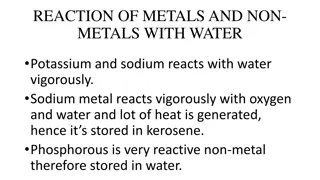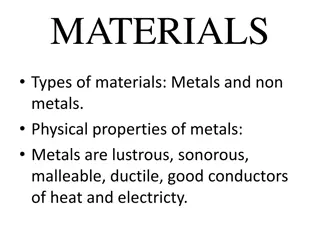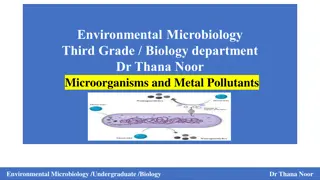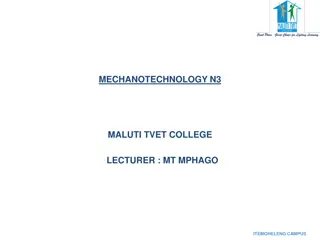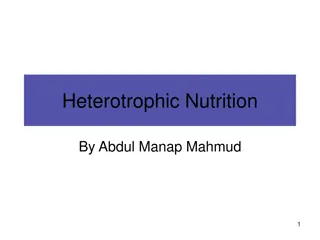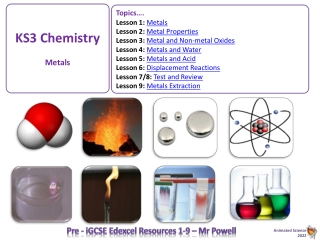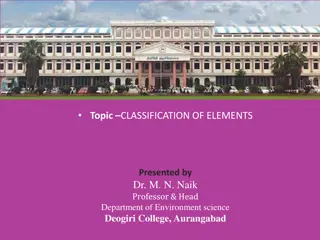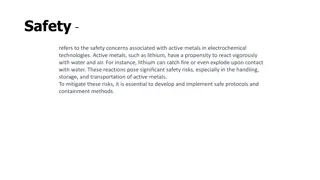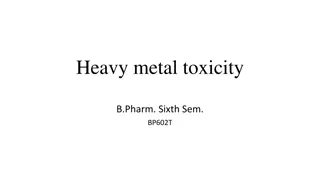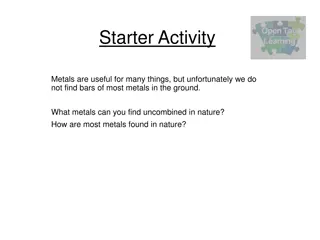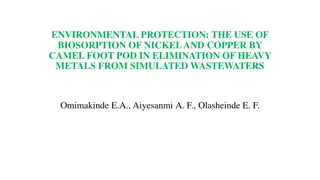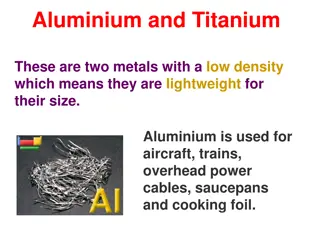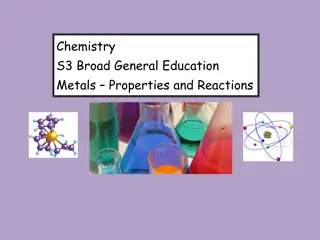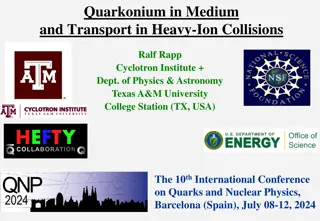Understanding Heavy Metals and Their Impact on Organisms in the Environment
Heavy metals, such as zinc and copper, persist in the environment posing health risks to organisms. Industrial activities release toxic metals into water sources. Microorganisms can interact with heavy metal ions, altering their toxicity and resistance. Essential heavy metals are needed in small amounts, but high concentrations can have detrimental effects on cellular growth. Some heavy metals like lead and mercury are toxic to organisms and the environment.
Download Presentation

Please find below an Image/Link to download the presentation.
The content on the website is provided AS IS for your information and personal use only. It may not be sold, licensed, or shared on other websites without obtaining consent from the author. Download presentation by click this link. If you encounter any issues during the download, it is possible that the publisher has removed the file from their server.
E N D
Presentation Transcript
Advanced Microbial Ecology Code no. 618B Pre-MSc. Students Lecture no. 9 Dr. Mahmoud Nour El-Dein
What is heavy metals? Heavy metals are known to persist in the environment and become a risk for organisms. Heavy metal pollution has become one of the major environmental problems that pose serious health hazard. Heavy metals are known to persist in the environment and become a risk for organisms. Heavy metal pollution has become one of the major environmental problems that pose serious health hazard. Different type industries use different type of heavy metals and directly or indirectly discharge waste water containing toxic substances into the environment. Trace amounts of heavy metals are required by living organism including copper, iron, zinc but however excessive levels of these metals can be toxic to the organism due to their toxicity and accumulation behavior. Different type industries use different type of heavy metals and directly or indirectly discharge waste water containing toxic substances into the environment. Trace amounts of heavy metals are required by living organism including copper, iron, zinc but however excessive levels of these metals can be toxic to the organism due to their toxicity and accumulation behavior.
The becomes compounds The factors nature Microorganisms lateral The toxicity becomes higher compounds. . The interaction factors like nature of Microorganisms acquire lateral gene toxicity of of heavy higher in heavy metal in the metal ions the cells, ions starts cells, due starts when due to when their to which their concentration which they concentration they form form complex complex interaction of like oxidation of metals, of microorganism oxidation state metals, growth acquire resistance gene transfer microorganism with state of growth phase resistance to transfer. . with metal the metal phase of metal ions metal ion, of microorganism to these ions depends ion, chemical/physical microorganism. . these toxic depends on chemical/physical on of the toxic metals metals by by
Heavy 5 5 g/cm The e e. .g g. . zinc, Such concentrations organisms If If the essential any Heavy metals g/cm3 3. . They The metals zinc, nickel, Such metals concentrations ( ( M organisms. . the metals essential metals any concentration metals are They are metals which nickel, copper, metals are are usually are classified which are copper, etc are required M to usually defined classified as are need etc. . required in to mM) defined as as essential need for as metals and non normal cellular metals having non- -essential cellular growth having density essential metals growth are density more metals. . are essential more than than essential and for normal essential metals metals in low all heavy low concentrations heavy metals concentrations ( (nM metals have nM), ), but detrimental effects but at at higher effects to higher mM) all have detrimental to metals have metals e e. .g g. . e e. .g g. ., , lead, concentration. . have no no known known biological lead, cadmium, biological function, cadmium, mercury function, they mercury. . Such they are Such metals are called metals are called as are toxic as non toxic at non- - at
Different methods have being used to decontaminate the environment from adverse effect of these pollutants but yet most of the methods used are not cost effective and far away from their best possible performance. Different methods have being used to decontaminate the environment from adverse effect of these pollutants but yet most of the methods used are not cost effective and far away from their best possible performance. Consequently the need to replace with biological method with are cheap and efficient method of treating metal effluents as these method may provide a possible way out to metal removal from contaminated environment. Consequently the need to replace with biological method with are cheap and efficient method of treating metal- -bearing effluents as these method may provide a possible way out to metal removal from contaminated environment. bearing
Sources of Heavy Metals The world anthropogenic emissions are larger than or equivalent to natural emissions for the majority of trace metals. the metals ions coming from anthropogenic sources may be accumulated in aquatic organisms and transfer to humans through the food. Consequently, human health risks may occur because water organism contaminated by heavy metals can cause many health problems. Sources of Heavy Metals The world anthropogenic emissions are larger than or equivalent to natural emissions for the majority of trace metals. the metals ions coming from anthropogenic sources may be accumulated in aquatic organisms and transfer to humans through the food. Consequently, human health risks may occur because water organism contaminated by heavy metals can cause many health problems.
Micro adopted these These Micro- -organisms adopted different these metals These strategies organisms are different strategies metals. . strategies can are present strategies to present in in industrial to cope industrial effluents cope up effluents. . They with the They have effects of have of up with the harmful harmful effects can be be metabolism metabolism dependent dependent or or independent independent. . One metal Biosorption One such metal binding Biosorption is is exhibited such strategy binding proteins strategy is is biosorption proteins present exhibited by biosorption which present on by bacteria, which is is binding on the bacteria, algae, binding of cell wall algae, fungi of metal metal ions ions with with the cell wall. . fungi and and yeasts yeasts. .
Recovery like Choice selected a a biosorbent Recovery of like thiosulfate, Choice of selected to biosorbent. . of biosorbed thiosulfate, mineral of desorption to prevent biosorbed metals mineral acids desorption agent prevent alteration metals can acids and agent should alteration of can be and organic should be of physical be done organic acids be carefully physical properties done using acids. . carefully properties of using agents agents of
Methods for removal of heavy metals: 1. Chemicals methods: Chemical precipitation, electrochemical treatment, oxidation/reduction. 2. Physical methods: Ion exchange, membrane technology, reverse osmosis, and evaporation recovery, filtration. 3. Biological methods: 1. Microorganisms including bacteria, fungi or algae. However, these strategies were not the first choice as they are expensive, inefficient, labor-intensive, or the treatment process lacks selectivity.
The research on bioremediation or biosorption-based remediation techniques in the past decades has concluded that bioremediation is a natural process and cost effective. 4. Biosorption: ability of biological materials to accumulate heavy metals from wastewater through metabolically mediated (by the use of ATP) or spontaneous physicochemical pathways of uptake (not at the cost of ATP), or as a property of certain types of inactive, non-living microbial biomass which bind and concentrate heavy metals from even very dilute aqueous solutions.
It is a complex process that depends on different-factors like cell physiology, physicochemical factors such as pH, temperature, contact time, ionic strength, and metal concentration, chemistry of the metal ions, cell wall composition of microorganisms. Biosorption of different heavy metals e.g. cadmium, silver, lead, nickel etc. by using microorganisms like fungi, algae or bacteria was studied by different groups.
Advantages 1. 2. 3. 4. 5. removal 6. presence 7. 8. Advantages of 1. Cheaper 2. Use 3. Multiple 4.Treatment 5. No removal of 6. Functional presence of 7. Easy 8. Reduced of biosorption production of of biomass Multiple heavy Treatment of No need of specific Functional over of other Easy and Reduced volume biosorption: : Cheaper production Use of heavy metals of large need for specific metals over wide other metal and cheaper volume of of biomass for removal metals uptake large volumes for chemical metals. . wide range metal ions cheaper desorption of waste biomass (bacteria removal of uptake at volumes of chemical additions (bacteria or of heavy at a a time of wastewater additions as or fungi) fungi). . biomass for heavy metals time. . wastewater. . as highly metals. . highly selective selective for for uptake uptake and and range of ions. . desorption of waste or of conditions conditions including including temperature, temperature, pH, pH, of metals or toxic metals attached toxic materials attached to materials production to biomass production. . biomass. .
Disadvantages 1. Saturation of active sites of metal binding ligands. 2. Reversible sorption of metals on biomass. 3. Metal accumulation. Disadvantages of of biosorption biosorption: :
Biosorption mechanisms dependent biosorption exhibited by like a a specific involves bonds adsorption dissolved on Biosorption mechanisms: biosorption: : living biological 1. is is exhibited like chelation specific way involves the bonds between adsorption; ; adhesion dissolved solid on the 1. Metabolism dependent by living chelation; ; way in the formation between a a polydentate adhesion of solid to the surface Metabolism biological material material. . It It involves involves various various mechanisms mechanisms in which formation or polydentate ligand of atoms, to a a surface surface of ions and presence of ligand and atoms, ions, surface. . This of the which ions or presence and molecules of two and a a single ions, or This process adsorbent. . It It is is a a surface bind to or more single central or molecules process creates surface phenomenon molecules bind two or to metal separate coordinate central atom, molecules from creates a a film phenomenon. . ions and coordinate atom, physical from a a gas, film of metal ions and it it more separate physical liquid, or the adsorbate gas, liquid, of the or adsorbate the adsorbent
2. Metabolism The consisting such The adsorption amine, role Living ability Metabolism independent The metabolism consisting of such physicochemical The adsorption adsorption. . Presence amine, hydroxyl, role in Living biological ability for independent biosorption metabolism independent of dead physicochemical biosorption adsorption process Presence of hydroxyl, phosphate, in metal biological mass for continuous biosorption: : independent process dead cells biosorption mechanism process can of anionic phosphate, and metal biosorption mass is is preferred continuous metal process mostly process is is the mechanism. . can be anionic ligands and sulfhydryl mostly occurs the main occurs in main key in biomass key point biomass point behind cells. . The The adsorption adsorption process behind be ionic ligands on sulfhydryl groups) ionic interactions on bacterial groups) also interactions or bacterial cell or physiochemical cell wall also plays physiochemical wall (carboxyl, plays an (carboxyl, an important important biosorption. . preferred over metal uptake, over dead and self dead mass, self- -replenishment mass, because replenishment because living living cells cells have have uptake, and
3. Metal accumulation: metals two not They cytoplasmic highly chemiosmotic starvation Metal accumulation: In metals must two types not require They are cytoplasmic membrane highly specific, chemiosmotic gradient starvation or In order must enter types; ; one require ATP are usually order to to have enter the one is is fast ATP. . usually driven membrane of specific, slow, gradient. . They or a a special have the the cell fast and the physiological cell. . Metal and unspecific, physiological effect Metal uptake unspecific, constitutively effect on system in constitutively expressed on the the growth in bacteria expressed and growth of bacteria is is grouped of cells, grouped in and does cells, heavy heavy uptake system in does only by of bacteria inducible and They are special metabolic the chemiosmotic bacteria. . The slow, inducible are only metabolic situation driven only by the chemiosmotic gradient The second and dependent only induced situation. . gradient across type of on ATP, induced in across the system is is addition to in times the second type dependent on of uptake ATP, in uptake system in addition times of to the need, the of need,
Biosorption by living microorganisms Biosorption by living microorganisms: : Bacterial Bacterial metal sulfate, of metal glycoproteins and different e e. .g g. . Bacillus size Bacterial biosorption Bacterial cell metal ions sulfate, amine) of metal metal ions glycoproteins. . Less and LPS Cell different metal Bacillus, , Pseudomonas size and biosorption: : cell wall ions get amine) present metal ions ions inside wall encountering get attached present on ions to inside cell Less metal encountering the attached to on the to reactive cell. . More metal uptake the metal functional groups the cell reactive groups More metal uptake by metal ion groups (amine, wall. . The groups present metal is is uptake by Gram the first (amine, carboxyl, general metal on bacterial uptake by Gram - - ve first component carboxyl, hydroxyl, metal uptake bacterial cell by Gram ve bacteria ion is is the of biosorption hydroxyl, phosphate, process involves wall followed Gram + + ve bacteria is is observed biosorption. . The phosphate, involves binding by internalization bacteria due observed due component of The to the the functional cell wall present on The general uptake process cell wall ve bacteria binding followed by internalization of due to due to of of to presence to phospholipids presence of phospholipids LPS. . Cell wall wall in metal ions Pseudomonas, , Escherichia and ability general, is is responsible depending on Escherichia exhibit ability to in general, ions depending responsible for on different for surface binding mechanisms exhibit biosorption environmental conditions surface binding binding sites mechanisms. . Various biosorption property conditions. . and binding Various bacterial property because sites and binding strength bacterial species because of strength for species of their for different binding their small small to grow grow in in different different environmental
Biosorption Fungal cell wall exhibit excellent metal biding properties due to its components. The cell wall of fungus is composed mainly of chitins, mannans, glucans, in addition to lipids, polysaccharides, pigments e.g. melanin. Fungal cell wall is reported to be made up of 90% polysaccharides. The functional groups which are involved in metal binding includes carboxyl, phosphate, uranic acids, proteins, nitrogen containing ligands, chitin or chitosan. Biosorption ability of fungal cells can be manipulated by physical of chemical treatments including autoclaving, heat processes or dimethyl sulfoxide, laundry detergent, orthophosphoric acid, formaldehyde, NaOH, respectively . Macro-fungi also called as mushrooms, grow wild in all types of environments ranging from forests to polluted soils and water bodies. They uptake the metals in their fruiting bodies, mycelia and sporocarps. Biosorption by by fungi fungi
Biosorption The free form of yeast cells is not considered good candidates for biosorption. Free cells face the problem of separation of solid liquid phase. This problem seems to be less effective in flocculating cell. Pretreatment of yeast cells can result in increased surface to volume ration for binding of metal with the metal binding sites. It is reported that pH above 5 In yeasts, higher concentration of heavy metals can be accumulated by bioaccumulation process than biosorption. However, general biosorption is responsible for the major uptake of heavy metals for many filamentous fungi. Biosorption by The free form of yeast cells is not considered good candidates for biosorption. Free cells face the problem of separation of solid liquid phase. This problem seems to be less effective in flocculating cell. Pretreatment of yeast cells can result in increased surface to volume ration for binding of metal with the metal binding sites. It is reported that pH above 5 optimizes the metal biosorption in yeast cells. In yeasts, higher concentration of heavy metals can be accumulated by bioaccumulation process than biosorption. However, general biosorption is responsible for the major uptake of heavy metals for many filamentous fungi. by yeast yeast optimizes the metal biosorption in yeast cells.
Factors 1. temperature carried damage 2 2. . pH sites of biosorbent Factors affecting 1. Temperature For temperature needed carried out damage to pH: : It It is is a a very sites of of pH biosorbent gets affecting biosorption Temperature: : For efficient needed to out between to proteins biosorption: : efficient removal removal of to be between 20 proteins which of metal be investigated 20 and which in metal ions investigated. . It It is is generally and 35 in turn ions from generally assumed 35 C C. . High turn affects from environment, assumed that High temperatures affects metal the optimum that biosorption above 45 uptake process environment, the optimum biosorption is is 45 C C may process. . temperatures above metal uptake may results results in in very important of biomass pH for gets compromised important parameter biomass. . At for metal compromised . . parameter. . It It affects At lower metal uptake affects solubility the biosorption between 2 2. .5 5 6 6. . Above solubility of of metals Above this of metal affected. . General this limit, metal ions ions and General range metal uptake and binding binding range ability of lower pH, uptake is is between pH, the biosorption of metals is is affected limit, metal uptake ability of
3 3. . Nature Metal uptake is reported in different forms like biofilms, freely suspended microbial cells or immobilization of microbial cells. It can be altered by physical or chemical treatments. Physical treatments include autoclaving, drying, boiling, sonication, etc. Chemical treatment as the name indicates involves chemicals like acid or alkali to improve biosorption capacity. the fungal cells are deacetylated which affects the structure of chitin resulting in the formation of chitosan-glycan complexes which have results high metal affinities. Nature of of biosorbents biosorbents: 4 4. . Surface This property plays an important role in efficient removal of heavy metal from medium. The surface area property plays a significant role in case of biofilms. The binding of metal ions with microbial cell wall is previously reported. Although intracellular metal adsorption is energy- consuming process but still microorganisms prefer it over wall adsorption. Surface area area to to volume volume ratio ratio:
5 5. . Concentration The concentration of biomass is directly proportional to the metal uptake. It is reported that electrostatic interaction between the cells plays an important role in metal uptake. At a given equilibrium, the biomass adsorbs more metal ions at low cell densities than at high densities. Metal uptake depends on biding sites. More biomass concentration or more metal ions restricts the access of metal ions to binding sites. 6 6. . Initial The initial concentration provides an important driving force to overcome all mass transfer resistance of metal between the aqueous and solid phases . Increasing amount of metal adsorbed by the biomass will be increased with initial concentration of metals. Optimum percentage of metal removal can be taken at low initial metal concentration. Thus, at a given concentration of biomass, the metal uptake increases with increase in initial concentration Concentration of of biomass biomass: Initial metal metal ion ion concentration concentration:
7.Metal Physical/chemical charges binding It It can detergents Metal affinity Physical/chemical pretreatment charges of binding. . can be detergents and affinity to biosorbent: pretreatment affects the biomass to biosorbent affects permeability makes metal permeability and binding groups and surface accessible for surface of the biomass and and makes metal binding groups accessible for be manipulated and heat, manipulated by heat, which by pretreating which may pretreating the may increase the biomass the amount biomass with amount of with alkalis, of metal alkalis, acids metal uptake acids increase the uptake. .


